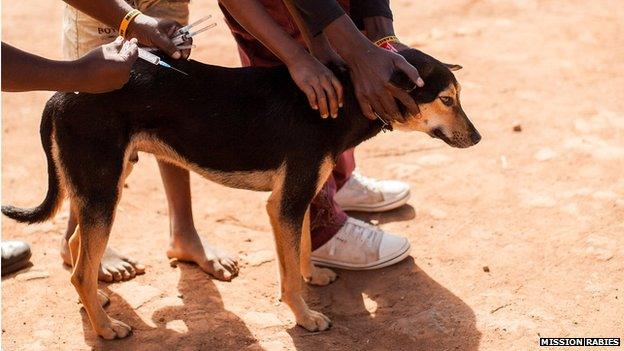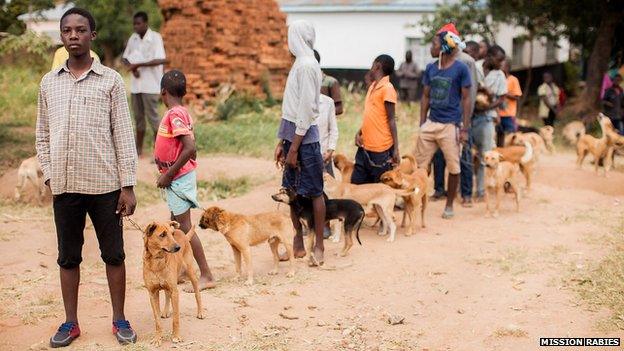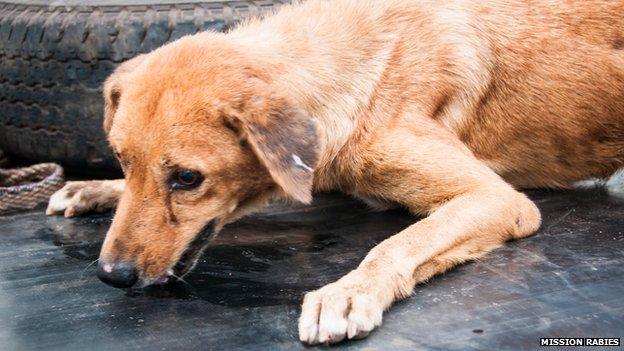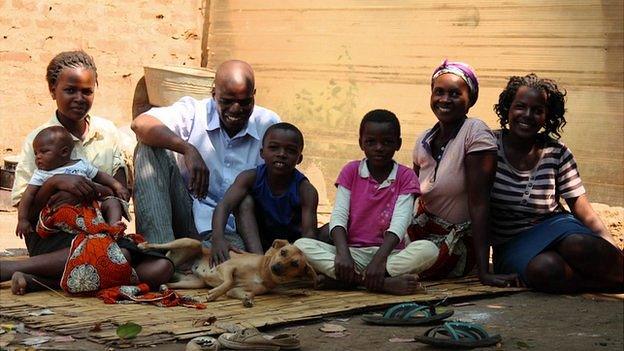Taking the bite out of deadly rabies
- Published
Vaccinating most dogs should stop rabies spreading to children too, as Lizzie Crouch reports
An estimated 59,000 people die every year from the deadly rabies virus.
Almost all of these deaths are the result of being bitten by an infected domestic dog. Avoiding these bites is an obvious solution. But how easy is it to spot a rabid dog?
Think of rabies and an image of a snarling dog, frothing at the mouth, probably comes to mind. But it is often not that straightforward.
A dog could have rabies or it could be angry. To the untrained eye, it is sometimes hard to tell.
An aggressive rabid dog has the furious form of the disease, but there is also a form called dumb, or paralytic, rabies.
Dogs in that state are often weak and lose co-ordination, so they do not appear as a threat but are just as deadly as the hostile animals.
If a person is bitten they can get post-exposure vaccine, but in poor countries this is often in short supply, meaning many people are not fortunate enough to receive it.
Once rabies symptoms start to show, a person is almost certain to die. But even then, rabies can be confused with other serious illnesses such as cerebral malaria or meningitis.

Mass dog vaccinations have successfully controlled rabies in many countries
Clearly, dog vaccination campaigns are the most effective way of reducing rabies cases in both dogs and humans, making them a vital tool in eradicating the disease.
The US and the UK have successfully introduced such campaigns, but in poorer countries it is a different story.
The campaign
Mission Rabies is a charity tackling the problem in Blantyre, southern Malawi. It aims to vaccinate up to 40,000 dogs; an estimated 70% of the local dog population.
According to recommendations from the World Health Organisation, this is the number needed for the disease eventually to be eradicated from the dog population - a concept called herd immunity.

Vaccination clinics have been set up around the city of Blantyre
"Each rabid dog might only infect just over one other, so it doesn't spread like a huge outbreak, but it just spreads slowly in the population," explains Kate Shervell, International Director of Mission Rabies.
"So by vaccinating 70%, the chances of a rabid dog biting a vaccinated dog is greater than [it biting] an unvaccinated dog.
"That's how it creates a barrier to the disease spread, and eventually the disease dies out," she adds.
The Mission Rabies campaign will need to be repeated every year for three years in order to ensure a sufficiently high vaccination proportion in a changing dog population, where new puppies are born and old dogs die.
The challenge
India is the country with the biggest burden of human rabies cases, with around a third of all human deaths from the disease each year.
But across Africa many thousands of others also die.
In some regions it is estimated that there are up to a hundred cases for every one that is officially reported, meaning rabies may be a bigger problem than studies suggest.

Once symptoms start to show the disease is almost always fatal.
Blantyre has one of the highest known numbers of children with rabies.
One man, Hanleck, had three puppies. After they were bitten by a stray dog, they started to become rabid and began biting anything that came near them, including his children.
He was worried that the children had also developed symptoms of rabies.
"They had headaches, severe back pain, they looked weak and lost their appetite," he explained.
Luckily, the children were not infected and received full courses of post-exposure rabies vaccine.
Mac Mallewa, associate professor of Paediatric Neurology at the University of Malawi, said they had been fortunate.
"There's been circumstances where a clinician knows this is a case of a rabid dog animal bite, but there's no rabies vaccine," he said.
"It's one of the most difficult things I've had to deal with as a paediatrician, [when] you know there's nothing you can do about it."

Hanleck's family were lucky - none of them was infected. Their remaining dog was vaccinated.
Rabies free
Mission Rabies is already seeing success from a programme it has been running in India for two years.
"When we began the programme we were picking up a rabid dog every month. And now, in the last five months, we've picked up two rabid dogs," said Kate Shervell.
"If we are seeing no more rabies cases in dogs, we really won't be seeing the cases in humans either."
It is hoped that, along with education campaigns in the local communities, Mission Rabies' current programme will create a rabies free Blantyre by 2017.